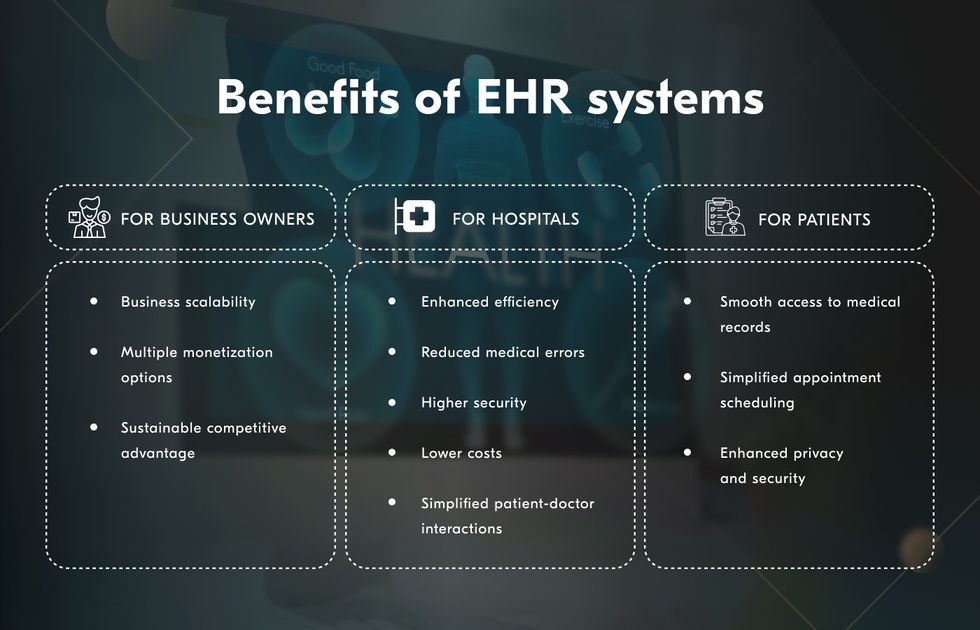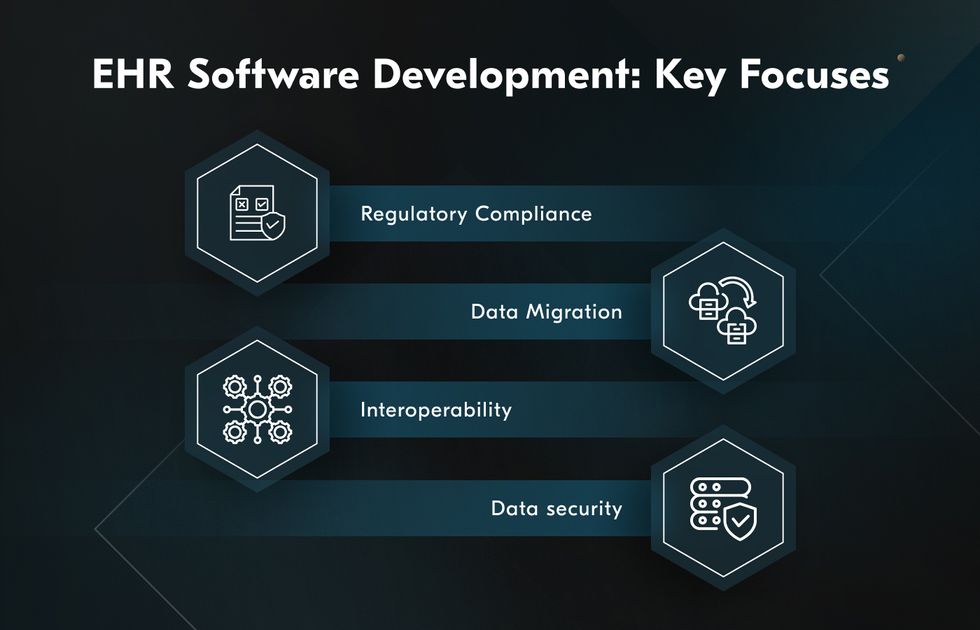
Key Takeaways
- After gaining momentum in recent years, the global EHR market reached $27.83B in 2024 and is projected to reach $41.87B by 2033.
- EMR software systems store practice-specific medical histories internally, whereas EHRs facilitate data sharing across healthcare facilities, enhancing efficiency by reducing redundancies and errors.
- EHRs offer diverse monetization models for medical businesses, while enhancing hospital operations through streamlined access to patient data and improving patient-doctor interactions.
- The cost of EHR software usually ranges from $50,000 to $500,000, varying based on requirements, desired features, team location, and third-party integrations.
Digitization is transforming healthcare, particularly through EHR and EMR systems, which streamline data management, consultation processes, and patient services. Traditional documentation is becoming obsolete as the sector shifts to electronic databases.
With 96% of US hospitals using Electronic Health Record platforms, medical businesses strive to remain competitive by enhancing experiences for both practitioners and patients. However, employing advanced tools and software is not enough; it takes a new perspective and approach to data management and compliance.
At Acropolium, we have been delivering secure healthcare software solutions for businesses of any scale — from small institutions to large enterprises. In this article, we’re giving an expert overview of EHR software development, its benefits, cost, and implementation based on our success cases.
What is Electronic Medical Records Software? Differences Between EHR & ERM

An electronic health record (EHR) system is a digital repository of patient health information. This data encompasses medical history, lab results, test outcomes, vaccinations, allergies, progress notes, medications, and insurance details.
Having established trending healthcare positions, the global EHR market surged to $27.83B in 2024 and is expected to hit $41.87B by 2033.
What is EMR Software?
Electronic medical records software is specific to a single clinic, and unlike EHRs, it doesn’t allow for information sharing among various hospital management systems and laboratories.
In other words, an EMR software system contains the medical history specific to one practice, and its data is solely used within a certain organization. EHRs, in turn, enable AI-driven data sharing across hospitals, clinics, and pharmacies, reducing redundancies, minimizing errors, and streamlining processes.
Types of EHR Software

EHR tools can be configured in various ways, each with its own advantages and disadvantages, based on a medical practice’s unique needs and requirements.
Physician-Hosted
In physician-hosted systems, all data is hosted on the physician’s own servers. This means that the physician is responsible for purchasing hardware and EHR software systems, as well as maintaining and securing the data stored on their servers. An EHR system managed directly by a physician within their practice can be advantageous for larger medical groups that can afford the substantial investment required for sophisticated software. On-site servers contribute to faster performance and increased system reliability.
Remotely-Hosted
Remotely-hosted systems transfer data storage responsibilities from the physician to an EHR/EMR software company, which handles maintenance, data backup, and security. This arrangement can be appealing to smaller practices or healthcare providers who prefer to focus on gathering information rather than managing data storage. EHR software solutions can be subsidized, dedicated, and cloud-based:
- A subsidized system involves a relationship with an entity that subsidizes the cost of EHR software. Generally, a physician forms this relationship with a hospital, which then controls the data. However, a remote system involving a subsidizing entity can raise legal issues, including antitrust and data ownership concerns.
- A dedicated host system implies that physicians store EHRs on a vendor’s servers, usually located in specific places. Medical specialists cannot control most aspects of data storage with this system.
- With cloud or SaaS-based remote systems, physicians do not need to store data on their own servers. Instead, the SaaS app development vendor stores it “in the cloud.” Consequently, the data is securely stored online and can be accessed through the vendor’s website.
Must-Have Features of Electronic Health Records Systems (EHR)

Custom EHR software solutions are designed to meet each client’s specific needs and requirements, leading to unique feature sets for every software. Nevertheless, every EHR must have key healthcare software functionalities, and your developers will ensure that these essential features are incorporated.
Patient Portal
A patient portal grants patients access to their health information. This platform lets patients review their medical records, test results, and medication history. They can also book appointments, request prescription refills, communicate with healthcare providers, and handle billing and payments.
Doctor Portal
The doctor portal gives access to patient information and manages clinical tasks. It allows doctors to view patient histories, lab results, and imaging reports, write prescriptions, schedule appointments, and communicate securely with patients and other professionals.
E-Prescriptions
Using e-prescribing functionality allows physicians to prescribe medications remotely. At the same time, they can access the required medical data to ensure drug compatibility while patients can also track their medication history.
Document Management
EHR software development can’t do without document management functionality: it organizes the storage, retrieval, and sharing of digital patient care documents. It supports scanning, indexing, and categorizing lab reports, medical histories, consent forms, and insurance information, ensuring easy access, reducing paperwork, enhancing data accuracy, and improving collaboration among healthcare providers.
Prescription Management
This functionality enables medical providers to electronically prescribe medications, check drug interactions, access patient histories, and transmit prescriptions seamlessly to pharmacies. It significantly reduces errors, improves adherence, and allows patients to request refills conveniently for ongoing care.
Clinical Records Section and Reporting
A custom EHR should feature strong reporting capabilities, giving practitioners a comprehensive view of patient data, treatment progress, and success rates. Patients can also use these features to monitor their treatment progress and upcoming appointments.
Data access control
EHR software systems handle sensitive healthcare data, so robust access control mechanisms are essential. Different access levels should be in place, ensuring compliance with industry regulations (HIPAA, GDPR, etc.) For example, the data protection policy will differentiate data availability for doctors and nurses — the latter won’t have the same access as the former.
Billing and Financial Dashboards
An EHR software solution should provide features to manage invoicing, claims, and payments, offer insights into practice finances like revenue and expenses, ensure billing compliance, facilitate audits, and provide visual summaries for efficient decision-making.
Integration with Other Healthcare Systems
Integrating EHR with test labs facilitates rapid data exchange and quicker decision-making. Test results are transmitted directly to applications, allowing easy access for both patients and doctors to take prompt action.
Some vendors utilize microservices architecture to ensure quick and smooth integration capabilities or create multi-tenant applications for broad data-sharing functionalities.
The benefits of EHR Software Solutions: For Businesses, Hospitals, and Patients

EMR and EHR systems have a huge impact not only on core medical activities but also on business operations and patient experiences:
For medical businesses, EHR solutions offer various monetization models, including subscriptions, freemium options, and pay-per-use models, making investments in EHR development highly lucrative.
For hospitals, they enhance operational efficiency by eliminating paperwork and providing quick access to patient data, lab results, and prescriptions. EHRs reduce medical errors with detailed patient data and analytics. Additionally, they improve patient-doctor interactions by streamlining administrative tasks and enabling electronic communication.
For patients, EHRs provide patients with easy access to their medical records, test results, and necessary documents for insurance claims and appointments. They also prevent redundant testing by giving healthcare practitioners comprehensive access to patient information. Since such app architectures are built with robust security protocols, patients can rest assured that their data is protected.
How Much Does EMR Software Cost?
Just like with any other healthcare applications, the cost of EHR software development varies based on factors like requirements, desired features, development team location, and third-party integrations:
- Advanced functionalities and intricate workflows increase development efforts and costs.
- Scalable architecture and tailored customization add to the overall cost.
- Integrating with external systems like laboratory or billing platforms adds complexity and cost.
- A well-designed, intuitive interface requires investment in design expertise.
- The choice of technical stack affects project complexity and cost.
- Compliance with healthcare regulations demands additional resources and increases costs.
Typically, the development costs range from $50,000 to $500,000. However, you should also keep in mind that each EHR software development company has different pricing models.
| EMR Complexity | Approximate Cost |
|---|---|
| Basic | $50,000 — $100,000 |
| Medium | $100,000 — $250,000 |
| High | $300,000 — $500,000+ |
Things to Consider When Building EHR Software Systems

When building electronic health record systems software, your organization’s decision-makers should take into account several critical factors to ensure a functional, secure, and compliant system. Key aspects to focus on include regulatory compliance, data security, data migration, and interoperability:
The software must adhere to healthcare regulations such as HIPAA in the United States, GDPR in Europe, and other local standards. Compliance ensures that patient data is handled legally and ethically, protecting both the patient’s privacy and the healthcare provider from legal repercussions.
Data migration is a significant challenge when transitioning from legacy systems to a new EHR platform. It involves transferring patient records, medical histories, and other critical data to the new system without data loss or corruption. This process requires careful planning, testing, and validation to ensure that all necessary information is wholly and accurately transferred.
Interoperability is crucial for effective EHR software systems, allowing them to communicate seamlessly with other healthcare systems. This interconnectivity facilitates the exchange of patient information across different platforms, improving care coordination and efficiency.
Why Choose Acropolium?
When developing EHR software, working with an experienced and verified vendor is crucial. Acropolium boasts strong expertise in building advanced healthcare solutions. Delivering GDPR-compliant software and following ISO-certified processes, we excel in secure cloud-based and serverless solutions. Here are some cases that demonstrate our approach to client success:
Blockchain-Based EHR Software Development
A client sought to enhance their existing EHR software system with a focus on improved data security, interoperability, and efficient data management. The primary requirement was to implement a solution that ensures data integrity, reduces retrieval time, and maintains high efficiency.
Solution & Results
Acropolium developed an EHR system by integrating blockchain technology to ensure tamper-proof data storage and secure data sharing:
- The solution included features such as encrypted patient records and seamless interoperability with other healthcare systems.
- Our developers provided a user-friendly interface for easy data access and management.
- The implemented smart contracts guarantee access to specific patient information only for authorized individuals.
- Finally, we ensured HIPAA compliance through rigorous security measures, regular audits, and adaptive system architecture.
SaaS Appointment Scheduling Software
A medical clinic needed a modern and efficient appointment scheduling solution to streamline its booking process and improve patient satisfaction. The goal was to reduce administrative workload and minimize appointment errors while enhancing patient experience through easy online scheduling.
Solution & Results
- The solution featured intuitive online booking capabilities, automated appointment reminders, and seamless integration with the clinic’s existing systems.
- It optimized appointment management and reduced patient no-show rates by 30%, improving operational efficiency.
- The easy-to-navigate and access software resulted in a 40% increase in patients using the tool.
Final thoughts
As the technological landscape evolves, the healthcare sector doesn’t stand still. Medical organizations are highly dependent on data security and compliance, embracing cutting-edge technology to remain competitive and deliver quality patient services.
Today, we have discussed how to develop an EHR system that meets your business’s specific needs with key software features and tips from our experience. And we will be there for you on your way to going digital.
Partnering with medical businesses for 15+ years, Acropolium delivers tailored solutions prioritizing efficiency and patient-centric care. Whether you require custom development services or software reengineering, we offer flexible subscription-based cooperation that values your objectives. Let’s chat!









![Kiosk Software Development for Healthcare Industry [Guide with Case]](/img/articles/kiosk-software-development/img01.jpg)

![Online Pharmacy App Development [2025 Guide]](/img/articles/pharmacy-app-development/img01.jpg)

![Doctor On-Demand App Development [2025 Guide]](/img/articles/doctor-on-demand-app-development/img01.jpg)
![Big Data in Healthcare: [Use Cases & Applications for 2025]](/img/articles/big-data-in-healthcare/img01.jpg)